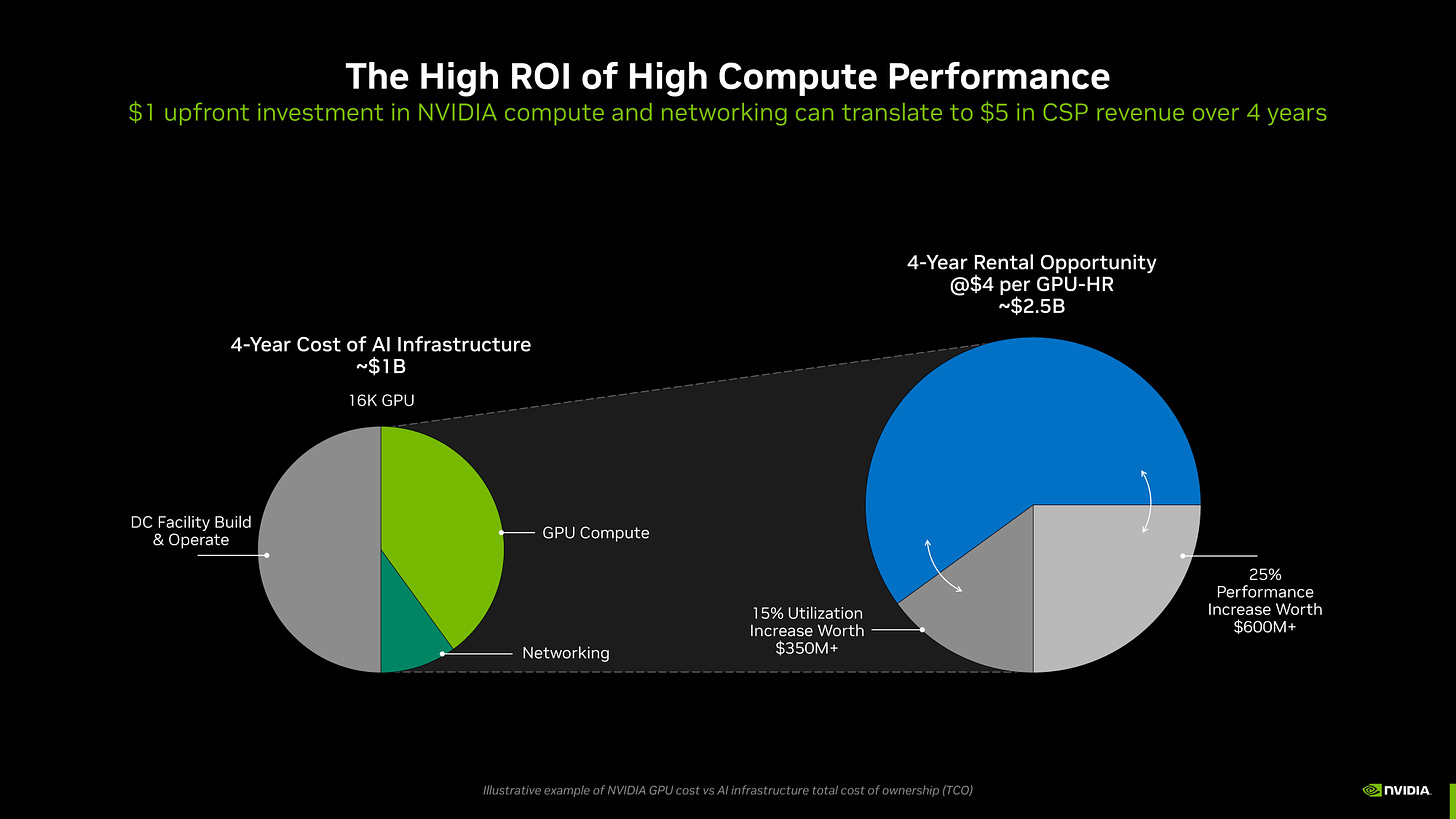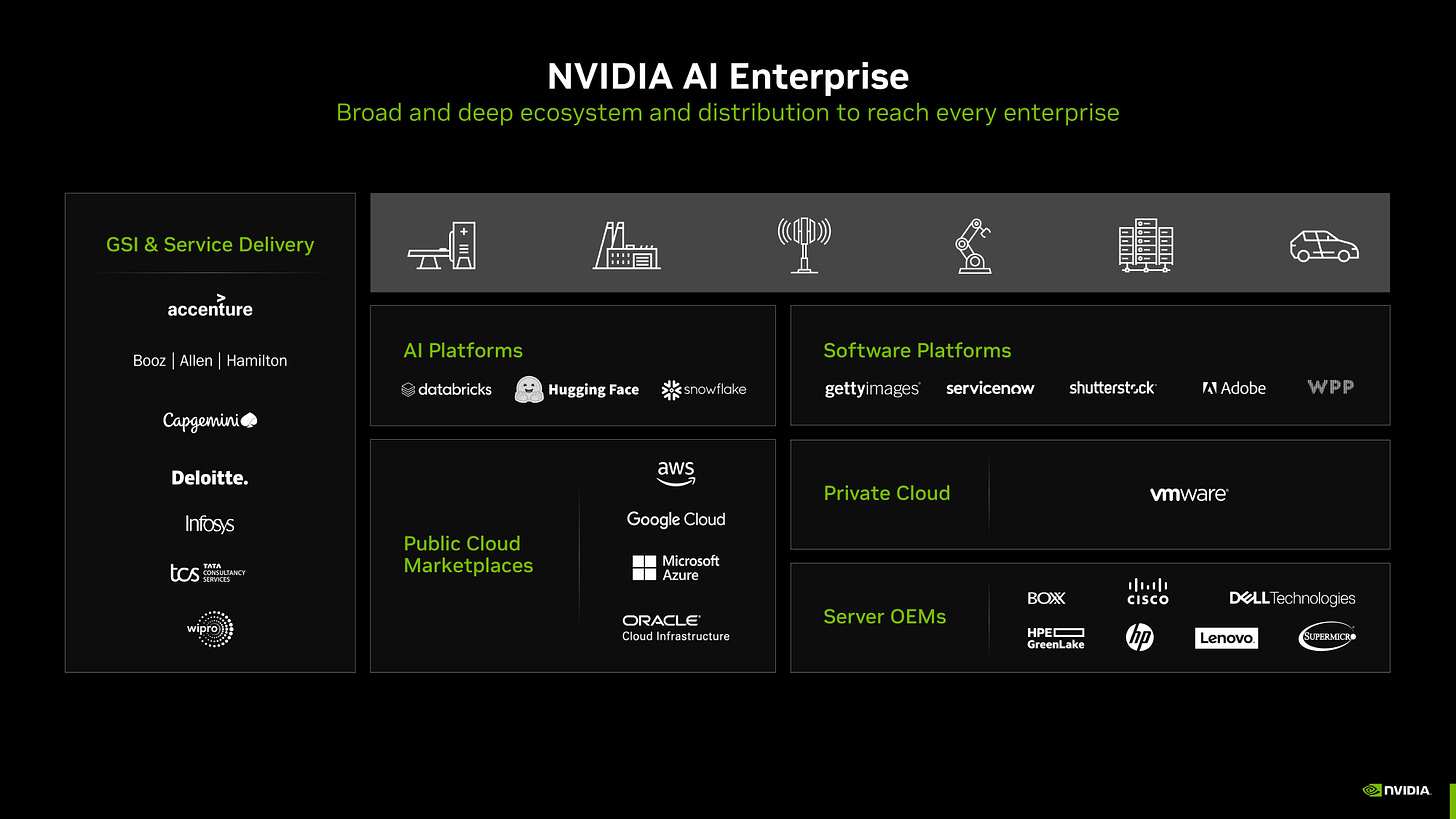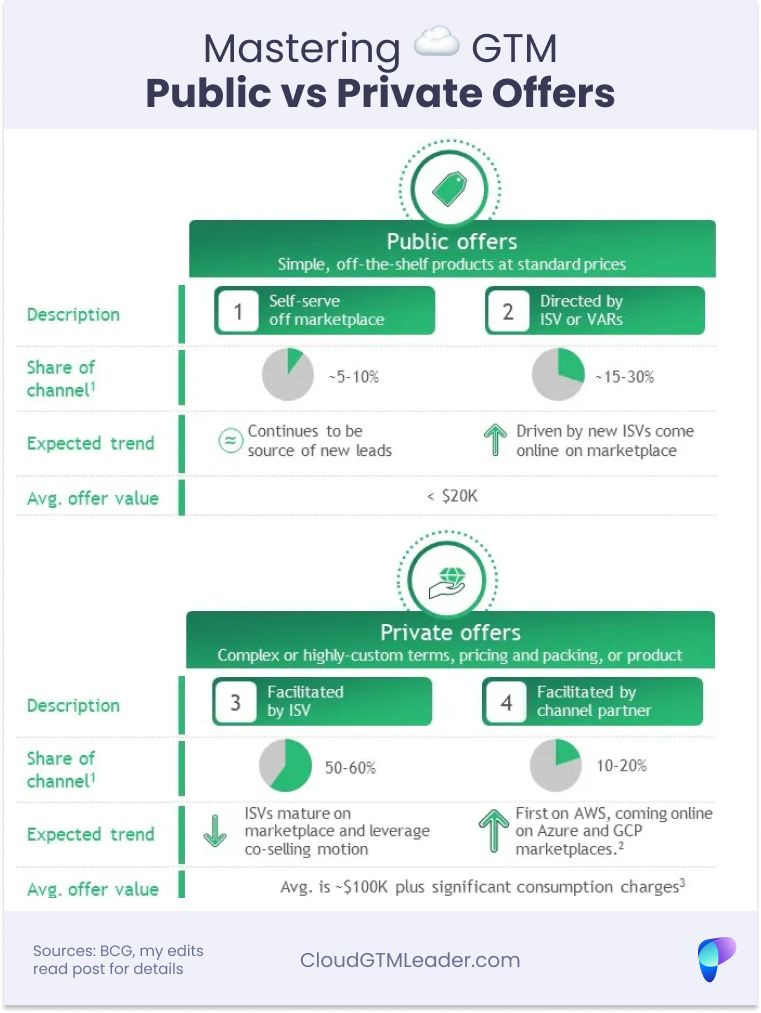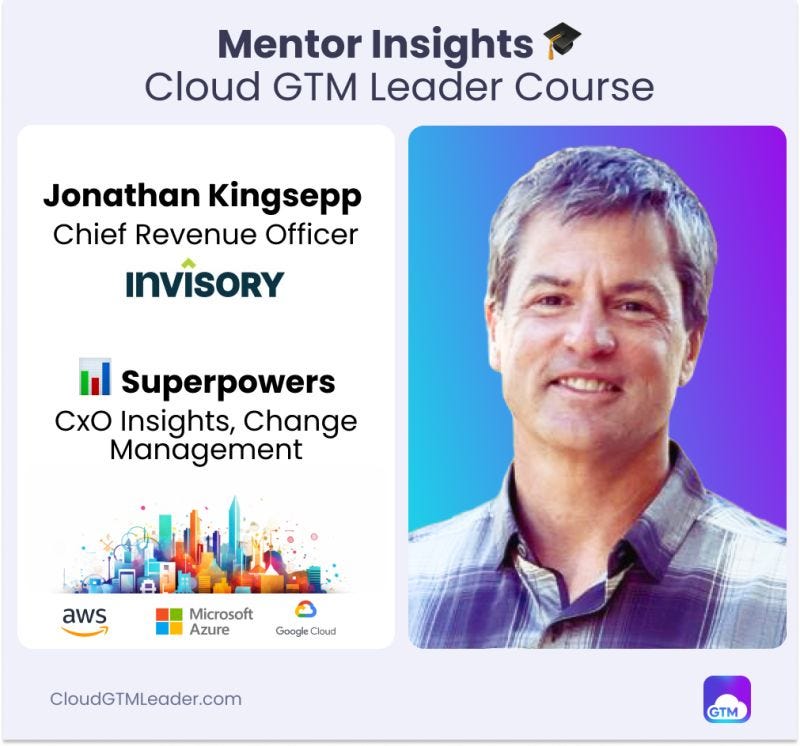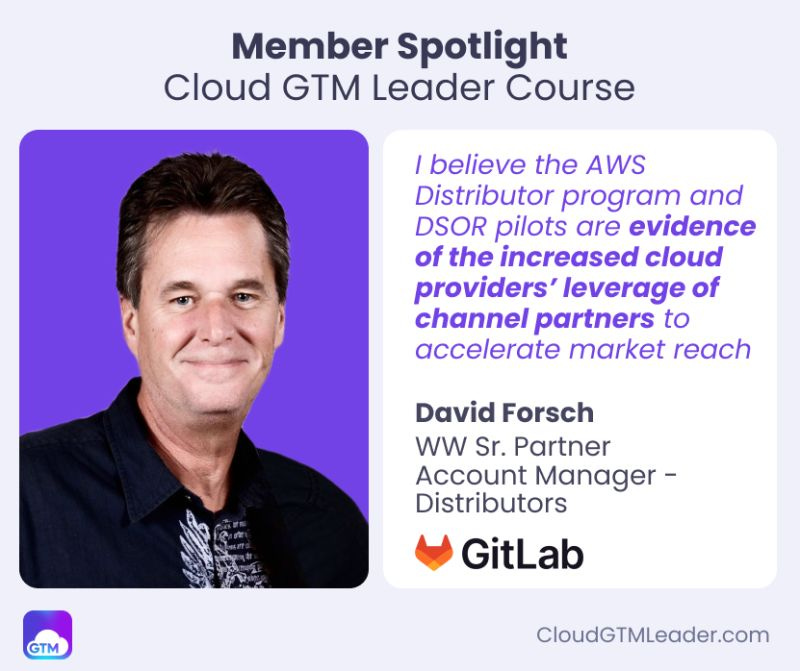Decoding Nvidia’s Massive Growth: AI and Cloud Partnerships
Hi, it’s Roman from Partner Insight. Welcome to my weekly newsletter, where I deconstruct winning Cloud GTM strategies and the latest trends in the rapidly evolving world of cloud marketplaces.
In this edition, we'll delve into Nvidia's remarkable performance, highlighting how cloud hyperscalers contribute to over 50% of the revenue for its product line, which accounts for 78% of its total revenue. I'll explain the use cases for Private vs Public offers in cloud marketplaces, and bring you exclusive insights from some of the most experienced mentors and members of our Cloud GTM Leader course.
Let's dive in.
Inside Nvidia’s AI Cloud Partnership Strategy
Last week Nvidia made history adding $277Bn to its market value in the biggest single-day gain in Wall Street history. It accelerated S&P 500 to a record close on Friday, fueling excitement over AI.
However, a key yet often overlooked part of Nvidia's success is its partnership strategy. Let’s examine its strengths and challenges.
The Core of Nvidia's Revenue Surge
The primary driver of Nvidia's skyrocketing revenue is its Data Center line of business. It includes GPUs, supercomputing systems, servers, software and networking offerings to help businesses run AI, data analysis, etc. faster and more efficiently.
Image: Nvidia’s Data Center revenue
Data Center grew 3X from the previous year reaching $47.5Bn in revenue in FY24 and now contributing 78% to the total annual revenue.
Intriguingly, the majority of this revenue stems from cloud hyperscalers.
AI Meets Cloud: A Synergistic Growth
Nvidia’s CFO, Colette Kress, revealed that cloud hyperscalers now account for over 50% of their Data Center revenue, which saw a phenomenal 409% YoY jump in Q4:
“In the fourth quarter, large cloud providers represented more than half of our data center revenue, supporting both internal workloads and external public cloud customers.”
This surge is rooted in Nvidia's compelling pitch to cloud providers that leverages the familiar multiplier concept:
“$1 upfront investment in NVIDIA compute and networking can translate to $5 in CSP revenue over 4 years”.
Nvidia's Distribution Strategy: Ecosystem Focus
Central to Nvidia's distribution and product allocation strategy (GPUs are still in high demand after all) is its emphasis on connecting customers with partners. CEO Jensen Huang emphasized the importance of this ecosystem approach:
“We have an excellent ecosystem with OEMs, ODMs, CSPs and, very importantly, end markets. What NVIDIA is really unique about is that we bring …our partners, CSPs and OEMs, we bring them customers.
The biology companies, the healthcare companies, financial services companies, AI developers, large-language model developers, autonomous vehicle companies, robotics companies…are working on NVIDIA's platform. We support them directly.
And oftentimes, we can have a twofer by allocating to a CSP and bringing the customer to the CSP at the same time. And so this ecosystem, you're absolutely right that it's vibrant. But at the core of it, we want to allocate fairly with avoiding waste and looking for opportunities to connect partners and end users. We're looking for those opportunities all the time.”
Friends or Frenemies in the Cloud?
Nvidia’s partnerships with CSPs are very nuanced. Nvidia is among companies that run the new generation Go-To-Market that balances both collaboration and competition.
In addition to its traditional competitors like AMD, Huawei, and Intel, Nvidia notably counts clouds as competitors:
“Our current competitors include… large cloud services companies with internal teams designing hardware and software that incorporate accelerated or AI computing functionality as part of their internal solutions or platforms, such as Alibaba Group, Alphabet Inc., Amazon, Inc., or Amazon, Baidu, Inc., Huawei, and Microsoft Corporation, or Microsoft”.
One of Partners Alone Drives $6B+ in Revenue
Despite potential competition, hyperscalers remain a key distribution channel and the largest customers for Nvidia.
While in FY22 and FY23 Nvidia didn’t have customers representing >10% of its total revenue, a shift occurred in FY24:
“We receive a significant amount of our revenue from a limited number of customers within our distribution and partner network. Sales to one customer, Customer A, represented 13% of total revenue for fiscal year 2024, which was attributable to the Compute & Networking segment [it includes Data Center mentioned above].”
“One indirect customer which primarily purchases our products through system integrators and distributors, including through Customer A, is estimated to have represented approximately 19% of total revenue for fiscal year 2024, attributable to the Compute & Networking segment.”
You may guess who might be Nvidia's largest customer that buys ~$9Bn [19% of revenue of the Compute & Networking segment] in annual revenue or both directly and indirectly via a partner (named above as Customer A that itself drives $6Bn in annual revenue).
The company noted that “Our estimated Compute & Networking demand is expected to remain concentrated”,
while its CEO underscored that “The large CSPs are still continuing to build out….And the way that we work with CSPs, that's really easy. We have large teams that are working with their large teams.”
Nvidia's Growing Presence on Cloud Marketplaces
Nvidia's software products are accessible on hyperscale cloud marketplaces, further cementing clouds as both the biggest customers and distributors for Nvidia.
Among them is NVIDIA AI Enterprise, its software for deploying and running AI with enterprise-grade security, API stability, etc. which is now available “in every major cloud marketplace”.
In FY24, NVIDIA also launched its DGX Cloud “an AI-training-as-a-service platform which includes cloud-based infrastructure and software for AI, customizable pretrained AI models.” To host DGX Cloud Nvidia “partnered with leading cloud service providers to host this service in their data centers.”
Nvidia’s CFO, Colette Kress highlighted:
“We also made great progress with our software and services offerings, which reached an annualized revenue run rate of $1 billion in Q4. We announced that NVIDIA DGX Cloud will expand its list of partners to include Amazon's AWS, joining Microsoft Azure, Google Cloud and Oracle Cloud. DGX Cloud is used for NVIDIA's own AI R&D and custom model development as well as NVIDIA developers. It brings the CUDA ecosystem to NVIDIA CSP partners.”
Anticipating Continued Growth
Nvidia expects continued growth in its data center business, driven by trends in accelerated computing and generative AI.
Jensen Huang emphasized that “fundamentally, the conditions are excellent for continued growth calendar '24, to calendar '25 and beyond.”
The company's strategic partnerships and presence in cloud marketplaces are likely to foster further expansion.
Mastering Cloud GTM: Private vs Public offers
In cloud marketplaces, understanding where to use Public and Private Offers is key to unlocking traction.
Let's break down their potential and impact.
Public Offers - PAYG on Cloud Marketplaces
Public offers are essentially self-serve purchases - they are used today by customers who directly buy low-to-mid cost pay-as-you-go (PAYG) products on marketplaces (MPs).
Price: $ to $$
User Personas: An example is a cloud architect seeking quick access to software solutions.
What Users Value: Ease of use and seamless integration with existing PAYG services.
Private Offers: The Revenue Drivers Today
Private Offers are bespoke contracts used on MPs for higher-priced, contract-based commitments.
Price: $$ to $$$
User Personas: Those committing to large 2-3 year contracts differ from smaller PAYG buyers.
What Users Value: Bespoke terms and configuration. Many procurement teams may not even engage with $$$ offerings on MPs without deeper discussions/negotiations.
Boston Consulting Group (BCG)'s 2023 research (see slide) highlights that Private Offers contribute up to 80% of MP revenue. This mirrors our Cloud GTM Leader members’ experiences - most companies leverage Private Offers.
The SaaS Free Trial Strategy
Free trials are emerging as a promising middle ground to maintain visibility while catering to the right user personas, for example on AWS MP. With free trials, ISVs can place their product in potential users' hands, fostering a smoother transition to larger commitments. Once users appreciate the product value, ISVs can engage with their procurement for private offers, selling longer-term contracts.
For ISVs with high LTV products, leveraging both free trials and private offers can result in a more effective sales strategy, tapping into the right customer personas at different stages of the buying journey.
A Potential Shift?
John Jahnke, CEO of Tackle.io, highlighted in our “How to Win in Cloud GTM” event in December that a growing number of companies are trying to enable customers to start their buying journey on MPs.
“Product led sales through marketplace - this was a new frontier this year…We're seeing this really come to life where at scale private offer sellers are saying:
“I've nailed the way private offers work. My enterprise sales team knows how to take advantage of this. We still have growth and lots of growth to come. But now we want to figure out how to improve top of funnel, how to integrate marketplace higher up into our process early or into our customer journey. That requires some more complicated listing types and potentially even more sophisticated integrations…
When these large sellers are saying “I want someone to initiate their journey on marketplace”, that's a change from using marketplace as a distribution fulfillment vehicle and I do think that shift in buyer behavior is a great signal.”
💡 Enroll in Cloud GTM Leader Course
Join our 5-week cohort course and accelerate your growth via AWS, Microsoft, and Google Cloud cloud marketplaces with 10+ leading experts in a community of exceptional alliance leaders.
Catch Early Bird seats for our April Cohort while they are still available.
Mentor Insights: Cloud GTM Leader Course
Delighted that Jonathan Kingsepp, CRO of Invisory, has joined our course Mentor program. Jont brings a decade of top notch experience in leading Cloud Alliances in companies like Tackle.io, Pivotal Software, Inc., OutSystems and others.
His superpowers include CxO insights, change management, and multi-cloud marketplace strategies. Jont is passionate about helping companies navigate change and simplify complex problems through software and solutions.
Jont shared with us his insights on how to turn a cloud marketplace motion into a successful Modern Cloud GTM program.
5 Step Post-Listing Playbook for Maximizing Cloud GTM
The key strategies begin in C-suite and involve almost every function within the organization:
1️⃣ Assess the operational impact - quote-to-cash workflows:
Functional teams typically impacted are Legal (contracts), RevOps (invoicing), Finance (cash collections, tax, etc.), Sales (enabled on “Marketplace” motion with customers), Partner Ops (enablement, awareness), Marketing (corp + partner marketing); Technology teams - accounting, ERP, treasury, etc.
2️⃣ Align your executive team - assess the business impact; ensure leaders understand the required investment, benefits and timeline.
NOTE: if new to this motion, build a 2 year plan
3️⃣ Activate your co-sell motion - build sponsorship with sales leaders, mitigate perceived risks from co-sell (particularly if the CSP offers competing solutions)
Build the “better together story”
Find relevant customer wins - running on the target CSP, quantified benefit; speak to what the CSP stakeholders are incentivized to do
Identify and connect with your counterparts at the CSP - alliances, sales, marketplace, product, specialized, etc.
4️⃣ Enable your sellers - both direct and indirect
The “marketplace” motion works for most, but not all. Ensure your direct and indirect (channel) teams understand when to present it
Build accurate expectations with customers - explain the purchase process; discuss authority to purchase, required roles and CSP subscription agreements
5️⃣ Build your KPI dashboard early - measure the process, focusing on milestone activities and outcomes
Awareness - leading indicators like # sellers enabled; # of CSP partner members enabled, leading sharing (in/out),
Co-sell activity - win rates, concentrations in partner contribution, etc.
Customer value - time to achieve customer value from a sale thru marketplace vs the customary workflow
Sales activity - measure top sales KPIs by channel - direct, channel, marketplace
PRO TIP: Maximize Cloud Partnerships Status
To maximize the value of this marketplace motion, maximize the partnerships status with the hyperscaler. Understand the levers used in these programs to elevate your status and develop a partnership strategy to obtain the highest level possible.
HINT: spending or influencing $$$ should be core to your strategy.
Member Spotlight: Cloud GTM Leader Course
I'm excited to spotlight David Forsch, WW Sr. Partner Account Manager - Distributors at GitLab, an incredibly experienced member of our course. David has shared with us his insights on the growing role of channel partners in cloud marketplaces.
With a remarkable track record in partnerships at companies like VMware, Citrix, and now GitLab, we're fortunate to have experts of David's caliber in our community.
Let's hear from David:
📝 Q: What is your top piece of advice or insight for peers navigating the cloud marketplace landscape?
“For ISV’s earlier in their journey, spend time to make a thoughtful decision about an offering that differentiates it in the eyes of the cloud provider(s) and their key go-to-market (GTM) role(s).
The offering should be mindful of a ‘better together’ story in the eyes of customers, which will get the attention of key sales stakeholders, cloud providers, and other partners.
The early goal is the first sale, then the second and then the fifth.
As with many partner GTM journeys, the first few steps can be hard, but repeatable success resonates with the cloud providers and their customer-facing professionals."
Q: Based on current trends and your experience, what predictions do you have for the future of cloud marketplaces in GTM? What untapped opportunities exist for partnership leaders?
“There are reports of expected increases in customer cloud spending commits.
I believe the AWS Distributor program and DSOR pilots are evidence of the increased cloud providers’ leverage of channel partners to accelerate market reach and partner services attach - resulting in increased customer usage of their commits.
ISVs should keep an eye out for this convergence as cloud providers quietly embrace it in their GTM strategies and programs.”
Cloud GTM Leader Course
"Lastly, the Cloud GTM Leader course was quite valuable for me.
Several experts repeated roughly the same handful of best practices for success, while adding their own valuable POV and experiences which are quite valuable when developing a strategy for this space.
Many ISV leaders are currently charting their course for this significant shift, and the value of learning - even for this long-time channel veteran was both validating and insightful as we enter into yet another sea change in the partner ecosystem."
📈 Enroll in Cloud GTM Leader Course
"Your course is just too good. You should be charging more for the value participants derive out of it." This endorsement from a leader in Cloud GTM at a renowned Silicon Valley company is just one of the many success stories you'll discover in our Cloud GTM Leader course.
April Cohort - Your Guide to Cloud Mastery
Catch Early Bird seats for our April Cohort while they are still available.
What Makes Cloud GTM Leader Course Stand Out?
Top-Notch Industry Insights: With our roster of incredible speakers, we'll continue to bring unique VP-level insights from experts in cloud marketplaces. They will guide you through the cloud GTM frameworks, strategies and tactics, diving into what's effective and what isn't in the rapidly evolving cloud marketplaces.
Our Weekly Mastermind Sessions is a collaborative space for you to strategize and tackle common cloud GTM challenges together.
Finally our vibrant Slack Community is a platform to continue these insightful discussions, gain further support, and build a network that extends beyond the live sessions.
P.S. Hurry up to catch Early Bird seats, while they’re still available!
Questions? Reach out at courses@partnerinsight.io





